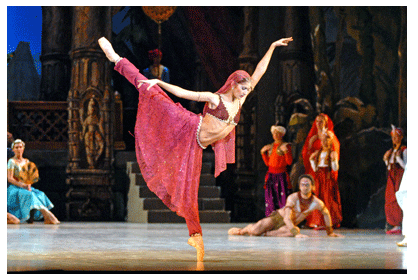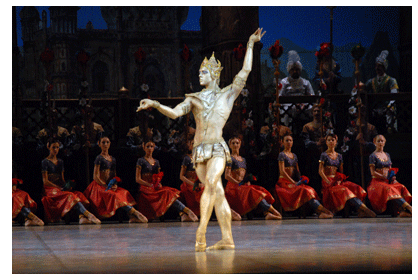- Prelude
- Hard Talk
- New Media
- Rolex : An Overview
- The age of Revivals: Neoclassical Furniture
- Democratization of the Medium No-Budget film: the Indian Context (!)
- Old Sound New Sound
- Decan Odyssey
- North East Opsis
- Russian cool breeze in hot Paris
- Around Kolkata
- Musings from Chennai
- In and around Santiniketan
- In between – from Vadodra
- A Tryst with Art in Madhya Pradesh
- Through the Looking Glass
- The Foreign Connection
- Market Insight
- Market Report
- Artist Index and Statistics
- Auction Reports
- The month that was
- Delhi Dias
- Art Bengaluru
- Mumbai Art Sighting
- Creative Impulse
- Subodh Gupta
- Pooja Iranna
- Preview
- In the News
ART news & views
Russian cool breeze in hot Paris
Volume: 2 Issue No: 9 Month: 10 Year: 2010
La Bayadère – The Novosibirsk Ballet
I went to Paris on work last July. Whenever I go back home for a little while, I check the art scene. This time, a friend of mine wanted to see a ballet … in the middle of a hot and quiet Parisian summer. I thought I could not please him until I remembered a young festival, Les Etés de la Danse (The Dance Summers). This year was their 6th edition.  They brought to Paris a troupe we do not see very often here, the Novosibirsk Ballet. Their last and only visit was in 1967. Unlike me, you probably know Novosibirsk is the 3rd biggest city in Russia and a kingdom for oil. Despite her industrial wealth, the Ballet's director, Igor Zelensky, complains about very stingy oil barons who are not supporting the local culture up to the profit they make there. He also indirectly complains about the choice of the central government to support the other two world famous Russian troupes, the Bolshoi (Moscow) and the Mariinsky (St Petersburg).
They brought to Paris a troupe we do not see very often here, the Novosibirsk Ballet. Their last and only visit was in 1967. Unlike me, you probably know Novosibirsk is the 3rd biggest city in Russia and a kingdom for oil. Despite her industrial wealth, the Ballet's director, Igor Zelensky, complains about very stingy oil barons who are not supporting the local culture up to the profit they make there. He also indirectly complains about the choice of the central government to support the other two world famous Russian troupes, the Bolshoi (Moscow) and the Mariinsky (St Petersburg).
But I have to admit that the Novosibirsk Ballet is impressing. Though they don't spend millions in costumes and scenery, they bring us the passion of dancing and a typical Russian excellence. That Friday, I went to the beautiful Théatre du Châtelet to buy my tickets for La Bayadère. The lady behind the counter asked me if I wanted the show or the master class. Without thinking, I said both obviously. What a great opportunity to offer my friend a unique experience! The class was amazing. The coach, a Russian lady, started giving instructions to the dancers, the stars of the evening to come. “Jeté, plié, relevé”. Once more “Jeté, plié, relevé”. What an interesting mix of languages. The coach speaks Russian and uses French technical terms, those imposed by the visionary Marius Petipa almost 150 years ago when he set up in Moscow and St Petersburg the basis of the Russian ballet school. We could see the dancers working hard at the barre. First arms and hands, then ankles and legs. They practiced their points.  Girls are disciplined and elegant. Boys are bullish and powerful. The spectators understand the efforts. They can feel the pain also. This is what it takes for a troupe to perform at its best.
Girls are disciplined and elegant. Boys are bullish and powerful. The spectators understand the efforts. They can feel the pain also. This is what it takes for a troupe to perform at its best.
The evening came and we sat in the theatre for La Bayadère, ready to welcome the lead stars, Leonid Sarafanov and Anna Zharova. La Bayadère was created in 1877 in St Petersburg by Marius Petipa. The music is by Ludwig Minkus. The première was a tremendous success. For various political reasons, La Bayadère was only shown in the West in the mid 40s. For some of you, the name of the ballet sounds familiar, doesn't it? The scenario takes place in India. It is a combination of love, jealousy, murder and revenge. La Bayadère, Nikkia, a temple dancer, loves Solor, a great warrior. But the ruling Raja wants his daughter, Gamzatti, to marry Solor. The Raja sends Nikkia a basket a flowers on behalf of Solor. It contains a snake. She gets bitten and dies. Before dying, Nikkia curses the Raja and his followers and predicts they will all die in the palace. Ignoring her, the Raja organizes the wedding between Gamzatti and Solor. The minute they are married, the palace collapses on the wedding guests. Solor and Nikkia can be together in heaven. The Novosibirsk Ballet mastered Marius Petipas' choreography. Every single step was on time coordinated with the music. Sarafanov proves again the superiority of the Russian ballet school in terms of technique. His power and precision took the audience to a trance. Zharova was extraordinarily elegant and refined. Every single gesture was measured and carried the right amount of emotions. Some critics found it too technical. I found the show warm and sincere. I found the troupe working as an ensemble, like a perfect team, almost like one body. I found them mature enough to support the lead dancers when needed. The Idol Dance was a great example and a demonstration of the troupe's dexterity. The Dance of the Kingdom of Darkness was full of joy and happiness though so technically difficult. The troupe made a remarkable come back to Paris. And Paris gave them a standing ovation for more than 20 minutes.